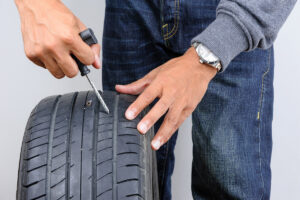How Long Can You Drive On A Plugged Tire?
Verified Accurate As of

Getting a flat tire while driving can be a frustrating experience, especially when you are in a hurry or on a long road trip. However, driving on a flat tire can cause serious damage to your car and put you and your passengers at risk. In some cases, you can plug a tire and continue driving, but for how long? The answer is not straightforward, as it depends on several factors that we will discuss in this blog post.
What Does a Plug Tire Mean?

First, it is important to know what plugging a tire means. It involves removing the object that caused the puncture, reaming out the hole, and inserting a rubber plug or a patch. Plugging a tire is a temporary fix, and you should always take your car to a professional tire shop to have it repaired or replaced as soon as possible.
Is it Better to Patch or Plug a Tire?
When it comes to repairing holes in your tire, patches are a better solution than plugs, especially if the hole is bigger, closer to the tread but not at the sidewall, or not completely straight. However, if you have a tire sidewall damage, a patch will not be sufficient and you will need to replace the tire altogether. It’s important to never patch a tire if the damage is near the sidewall.
How Long Does a Plug Tire Last?
The amount of time you can drive on a plugged tire depends on the location and size of the puncture, the type of tire, and the driving conditions. If the hole is in the center of the tread and smaller than a quarter inch, you can drive on the plugged tire for up to 50 miles at a speed of no more than 50 mph. However, if the puncture is closer to the sidewall or larger than a quarter inch, you should not drive on the plugged tire and replace it instead.
Can You Plug a Run Flat Tire?
As a general rule, it is advisable to only plug a tire that has punctures no larger than 1/4 inch. If the puncture is bigger than that, it is best to seek the assistance of a professional technician for proper repair. Additionally, drivers should be cautious when plugging a tire as even a slight error during the process can result in significant damage.
When it comes to the million-dollar question of whether you can plug a run-flat tire, the answer is yes, but it’s not advisable to do so. While you can use a tire plug kit to seal the puncture and keep driving, doing so may cause irreversible harm to the run-flat tire, just like with regular tires.
Conclusion:
In conclusion, driving on a plugged tire should be avoided whenever possible, as it can compromise the safety of your car and your passengers. In case of a flat tire, pull over to a safe spot and assess the damage. If you can plug the tire and drive to a tire shop, do so cautiously and for a limited distance and time. Otherwise, call a roadside assistance service or use a spare tire if available.

